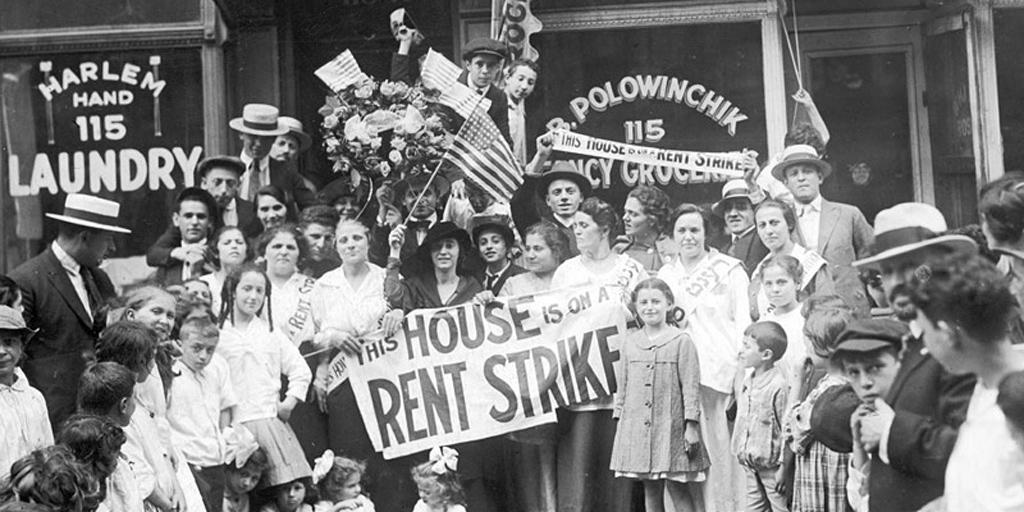
So You Want to do a Rent Strike?
Tenant Unions (TU) can be a weapon for struggle that the working masses wield against their landlord, the “second boss”. This is who, after receiving your meager wage from your first boss, you have to hand 60%, 70%, or maybe more to for the privilege of living in a home where the rent always goes up! They can both work to fight back against your landlord and build community in your building. What is the main form of struggle of a TU? How do you wield it and what kind of wins can it bring you?
The main form of struggle of a TU is a rent strike. A rent strike is when you and your neighbors get together and withhold your rent from your landlord until they meet your demands. Some rent strikes last only a few months but some can go for years! There are different types of rent strikes.
The “lower form” of a rent strike sometimes looks like a utility strike. This is when a group of tenants withhold their payments for water, electricity, etc. This can act as a first “shot across the bow”, putting your landlord on notice that you and your neighbors won’t put up with the conditions they force you to live in any longer.
But how do you build up to a rent strike? The first step is to go talk to your neighbors; get a sense of what problems you and they share and get their contact info. Let them know you want to start holding meetings where you all can get together and talk about the common and shared problems you are having in your housing and work on solutions.
At the meeting you want to make a list of the most important issues people are having in your complex. do a lot of people struggle with mold? is it rat infested? Does maintenance take a long time to fix issues or does it not even come at all? or does it just cost too much? Once you have a list, order it by which issues are most pressing and the ones most people have. With this information you are gonna work on a Demand Letter. This is where you write out what problems you are having, propose solutions, and let the landlord know that you have formed into a TU to fight for better housing. Everyone who supports the TU and the Demand Letter signs on to it before you send it in to show the landlord you have the support of a large portion of the tenants.
Most of the time the landlord will try to appease you by fixing some of the low hanging fruit, but ignoring the most important (and costly for them) issues. Sometimes they might even try firing the Property Manager (PM), blaming them for the issues. But the reality is PMs only do what they are told to do by the property owner and your real enemy is the landlord.
After this, the order of the day is escalation! This can take a variety of forms: putting up posters at your complex with the problems you are having to show other tenants they aren’t alone, holding a rally out front of the complex or at the office of your property manager, and more. But ultimately, in the vast majority of cases, to get the changes in your housing you need and deserve, you are going to have to wield your ultimate form of leverage, the rent strike.
When the time comes, other methods of struggle have failed to move your landlord, and your fellow tenants are ready for it, you will hold a special meeting of your TU where you discuss the strike. You will democratically decide on what is the most important issues that are a hardline, and which you can be more flexible with. Next a date is decided on when the strike will begin! Once this has been done the TU’s leading body will draft an internal document where everyone commits to the strike, commits to refusing to undertake separate negotiations or buy outs from the landlord, and signs their name to show this commitment.
Then when the hallowed day arrives, everyone will withhold their rent. The landlord will likely lose their head when this occurs and make all kinds of threats to try to split your ranks! But it is important for you and your fellow tenants to keep a cool head, to let the landlord know that they must undertake negotiations with the TU if they want to have rent payments resume. Then starts the (possibly) long process of maintaining your forces, keeping solidarity high, and having a back and forth with the landlord until they buckle.
So, this brings us to the question of what can be won in a rent strike? The answer is nearly limitless. Rent strikes in our country have won: clearing all back rents, ending all evictions, major repairs and mold remediation, lowering utility payments, rent equalization between units, and even establishing a formal process for solving future issues by having the TU communicate with ownership. If we dare to struggle, we can dare to win!
This is just a brief overview of the process and we could say more on each individual part. We hope that it will nonetheless inspire you to take up this form of struggle together with your neighbors and fight back against your second boss for better housing!
